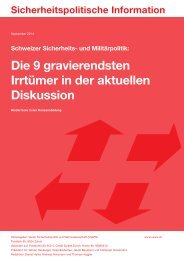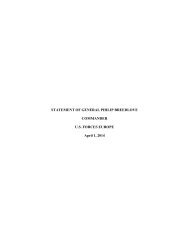FULLTEXT01
FULLTEXT01
FULLTEXT01
Create successful ePaper yourself
Turn your PDF publications into a flip-book with our unique Google optimized e-Paper software.
TACTICAL THOUGHT<br />
2014 September 29 th<br />
In Sweden, however, the first normative text also including descriptions of Irregular<br />
Warfare and COIN was published in 2010 184 . Work on tactical field manuals and<br />
regulations started in Sweden from 2008. 185<br />
A Diverging and Dual Result<br />
The question; how does the descriptive result of tactical thought compare with current<br />
normative standards for Counterinsurgency operations is answered the following way.<br />
In broad terms, it is suggested that the examined normative texts outline tactical<br />
thinking based on broader military-civilian task context thinking, with capability<br />
requirements for smaller, as well as larger units, not only intelligence focused but<br />
clearly also with offensive combat capabilities.<br />
Regarding contextual thinking, normative standards are positioned at the lower part of<br />
the model, described as a Hybrid Warfare context. As for conceptual thinking, a<br />
position of the normative texts is found on the left side in the model, focusing on<br />
smaller as well as larger unit operations, combining intelligence and combat tasks. The<br />
result is subsequently interpreted as a Swedish tactical preference, more diverse and<br />
only partly corresponding to normative standards for Counterinsurgency operations.<br />
Background to the result – four questions on COIN tactics<br />
Following a dialogue with the Swedish Army Ground Combat School<br />
(Markstridsskolan, MSS), several specific questions of interest arose during May 2011<br />
and a study was initiated. Four of these questions are included in this extract, focusing<br />
on primarily conceptual and contextual aspects of tactics in Counterinsurgency<br />
operations. The questions were the following;<br />
1. What characterizes the description of the Insurgency movements to be analysed<br />
and understood (e.g. systems thinking and the concept of Centre of Gravity) This<br />
question can be characterized as a contextual question with emphasis on analysis<br />
needs because of a broader threat perspective (Question 2 in the appendix).<br />
2. What characterizes the description of the insurgency movements to be affected<br />
(e.g. effects thinking, the concept of Effects Based Approach of Operations and<br />
Targeting) This question can be characterized as a contextual question, with<br />
focus on how to deal with Insurgency in general; for example with primarily civil<br />
or military means, and with kinetic or non-kinetic effects, which require other<br />
resources compared to those in Regular Warfare (Question 3 in the appendix).<br />
184 Militärstrategisk doktrin 2011 med doktrinära grunder (MSD 12) (2011).<br />
185 Reglemente för Markoperationer, (RMO) (2009) is one example.<br />
94





